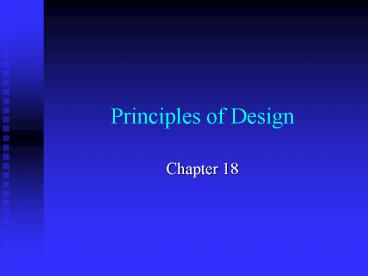Principles of Design - PowerPoint PPT Presentation
Title:
Principles of Design
Description:
Principles of Design Chapter 18 ... forms, or textures in a regular pattern; can be achieved with repetition, radiation, ... – PowerPoint PPT presentation
Number of Views:52
Avg rating:3.0/5.0
Title: Principles of Design
1
Principles of Design
- Chapter 18
2
Proportion
- Proportion is the relationship of objects or
parts of objects to one another and to the design
as a whole - The most effective proportion is a ratio of 23
- Uneven proportions are more pleasing and
rectangles are better than squares
- Furniture should always be in visual proportion
to other pieces of furniture in the room the
wall in which it will be placed - In architecture, the openings and solid portions
of the home should not be equal
3
How is this room in proportion?
4
Scale
- The proportion of an object or a space to human
beings and to the objects or spaces in a design - Furniture should be in proper size relation to
other furnishings and to the room itself
- Rooms furnishings should be designed for the
people who will use them
5
How is scale shown in this room?
6
Balance
- Symmetrical balance is the arrangement of forms
on one side of an imaginary central line is the
mirror image of forms on the the opposite side - This type of balance is more formal and the
easiest to achieve
- Asymmetrical balance is when elements on either
side of an imaginary central line are unmatched
but appear to be in balance - Different sizes, forms, textures and colors may
be used to achieve this look
7
Which type of balance is this?
8
How is this asymmetrical balance?
9
Rhythm
- Principle that creates an effect by using certain
colors, lines, forms, or textures in a regular
pattern can be achieved with repetition,
radiation, gradation - Repetition can be found in the repeating stripes
on wallpaper, design in a tile floor, or woodwork
that runs at the top or bottom of a wall
- Radiation occurs when lines radiate from a
central point chairs around a round table, small
items grouped around a large one - Gradation is the gradual increasing or decreasing
of color, size, or pattern gradual change is
more pleasing than an abrupt one
10
What type of rhythm do you see?
11
Emphasis
- Special forcefulness of expression that lends
importance to an item that is singled out
creating a focal point - Guidelines to follow when choosing something to
emphasize - Item or feature should be worthy of being singled
out for attention - It should dominate the room, but not overpower
the rest of the room design - No other item or feature should compete for
attention with the one singled out
12
What object is being emphasized?
13
Unity Variety
- Unity occurs when all the parts of a design are
related by one idea this creates harmony - Can create unity by repeating like items in a
design, but its not sameness
- Variety occurs when different styles and
materials are combined - Adds interest to a design, but too much creates
confusion - To be effective, unity and variety must be
combined to create a harmonious effect, both in
furnishings and in architecture
14
What elements add variety to this room?
15
What elements make this room unified?































